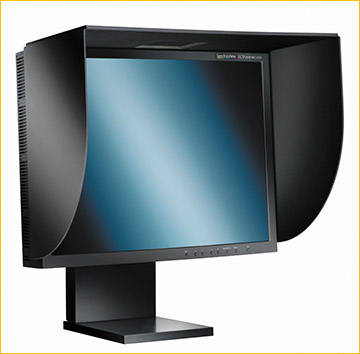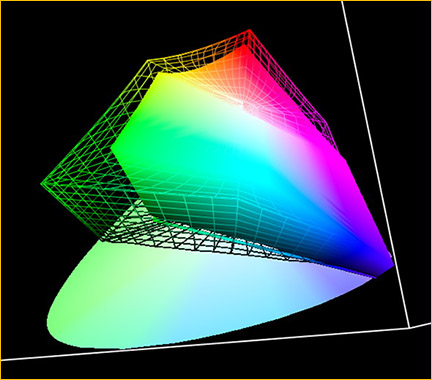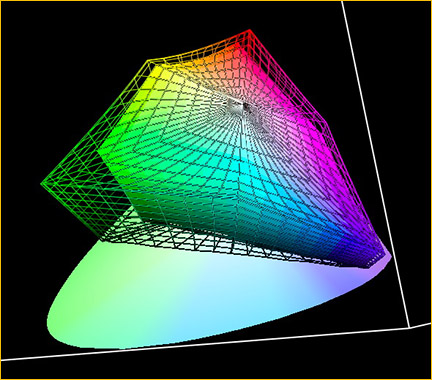
A good place to start this review is likely with the disclaimer that I am not really qualified to produce atechnicalreview of this monitor. I am a photographer, not a colour scientist. To properly put this fascinating new LCD monitor through its paces would require more test equipment than I have available, not to mention more knowledge of colour science and monitor technology than I have at my disposal.
But, since this is a device aimed squarely at the photo professional, I will report what I see, and how it compares to some other benchmark displays. I will also discuss the technology used, why it’s important, and what we might expect in the future.
Firstly, do not confuse theNEC 2180WGwith the2180UX. TheUXis a very nice 21″ LCD monitor that sells for about $1,500. This is essentially the same monitor as the popular and well regardedLaCie 321. The brand new2180WGmodel is a whole new ball game though. A very expensive ball game at that, given that it retails in the US for about $6,500, making it just about the most expensive monitor that you can buy this side of NASA or Pixar.
The mojo of this monitor lies in two areas; it uses LEDs as its illuminant rather than fluorescent tubes, and it is aWide Gamutdevice (WG), capable of displaying the Adobe RGB colour space, rather that being limited to sRGB, the way almost every other monitor is. Let’s look at the case for LED’s first.
By the way, NEC hasa technical paperexplaining the various aspects of this display technology.
_______________________________________________________________________
LED’s
The LCD display panel is an IPS device, the same as in most common high-end displays. But it’s the source of the illumination behind the panel that is different. Instead of flourescents, LED’s are used. Anyone who owns one of the new LED flashlights knows how bright and efficient these bulbs can be. Known asLumileds(Philips technology) this monitor has 48 LEDs (18 red, 20 green and 10 blue).
The LED illumination makes for an extremely bright screen. Potentially much brighter than you would normally wish or can use in a typical office, home, or studio environment.
I found the illumination to be quite even, though not perfect. With a black screen (on an unused input (there are two (digital only))) there is slight brightening in the corners, though much better than is to be seen on most other LCD monitors which use fluorescent tubes. Otherwise evenness of illumination is excellent, and the possible viewing angle is very wide, with very low to nonexistent colour shift when viewed at extreme angles. This is among the best LCD monitors I’ve ever seen for constancy of viewing angle.
_______________________________________________________________________
Adobe RGB
The 2180WG’s claim to fame is its wide gamut, encompassing the Adobe RGB colour space. Below is a gamut plot created inColorThink. It shows in wireframe a view of the 2180WG’s gamut, as produced by profiling the monitor with aGretag Macbeth Eye Onespectrophotometer. The solid gamut area is the sRGB colour space, which is what most other monitors display.
As you can see the 2180WG does indeed encompass a wider colour space than does a typical monitor. In some area it actually exceeds Adobe RGB, though in others it’s a bit shy. Nevertheless, this monitor really does for all practical purposes meet its claimed goal of encompassing the Adobe RGB colour space.

Wireframe = Monitor Gamut
Solid area = sRGB color space
While working in ColorThink I took a look at how the 2180WG’s gamut compares with that of the Sony Artisan. That comparison is shown below. As can be seen, it’s quite a bit larger.

Wireframe = NEC 2180WG
Solid area = Sony Artisan CRT
But, specs and gamut charts don’t tell the whole story. The real question is – is this larger colour space meaningful and usable? Ina threadon this site’s discussion forum back in December, ’05,Karl Lang, the designer of theSony Artisanand theRadius PressView, two of the most highly regarded CRT monitors, makes some cogent observations about the current state of wide gamut LCD monitors. His contention is that the chain from Photoshop, through the Operating System, the graphics card, and even the DVI spec, simply don’t warrant and can not properly support a wide gamut display. Lang points out that of the handful of currently available wide gamut displays only the 2180WG has a full 10 bit DVI interface with a full 10-10-10 data path. But, that there are currently (even now, 6 months later, in mid-2006) no computers, OS’s, or graphics cards that can support it. So one thing that the 2180WG does buy you is some protection against obsolescence.
So, as far a the real-world use of wide gamut monitors goes, it seems that devices like the NEC 2180WG are somewhat ahead of themselves. Maybe in a few years, when the rest of the pieces in the imaging chain catch up, this monitor’s wide gamut will be truly usable. Certainly the 3 year warranty and the extra long life that LED’s provide means that you’ll likely be able to amortize your investment over a long period of time. But, of course, technology marches on, and prices of high-tech items tend to fall over time, so this isn’t a clear cut decision.
_______________________________________________________________________
By Way of Comparison
I like science and measurements as well as the next guy. But, I’ve learned over the years that not everything can be tested and measured. Or at least that we may not always know eitherwhatto measure, andhowit might correlate with what we’re seeing. So, now that the scientists and engineers in the audience are suitably annoyed, let me describe what I see and my points of reference.
For the past 2+ years my primarily image processing monitor has been theSony Artisan. (Sadly, the Artisan was discontinued about 18 months ago and there is no longer anything like it available on the market). The Artisan is (has been) the gold standard reference monitor for many photographers for the past 5 years. Since CRTs have about a 3 year life span before they begin their noticeable but inevitable deterioration, I suppose I have 1 or at most 2 years of useful life left on mine.
I also have on my desk the original23″ Apple Cinemadisplay(the one with the ribbed surround). This sits right beside the Artisan, for use with my second computer. Though not quite in the same performance category as the Artisan, it’s damn good, and I find it preferable to use for many non-critical colour tasks. The third screen is that of the new 17″ Macbook Pro, arguably the best laptop LCD produced thus far by Apple, and among the best anywhere (though not in the same league as the others mentioned here, at least for critical work).
Each of these monitors has been calibrated and profiled with theGretag Macbeth Eye Onespectrophotometer and eitherColorEyes DisplayorEye-One Match.
So, what do I see? When calibrated and profiled properly, on a wide range of images the 2180WG and the Artisan appear very close (which doesn’t surprise me). Looking at images that have a very wide gamut from inside Photoshop , and in the very widePro Photo RGBcolour space, I can’t say that the fact that the 2180WG has a wider gamut is all that apparent. I’m sure that with synthetic images I could show that this is indeed the case, but frankly real-world images that allow one to really see the difference are few and far between.
What I do see is what appear to be ‘sharper” images on the NEC. When I peer closely at the monitors this impressions doesn’t stand up, but at normal viewing distance there simply is an overall greater impression of sharpness from the NEC over the Artisan. This is likely an LCD vs CRT thing, since I see the same thing when comparing the Artisan with the screen on my 17″ Macbook Pro.
And speaking of the 17″ Macbook Pro, its screen is a significant step up from that on the previous 17″ Powerbook. When properly profiled I find it to be very usable, even for some colour-critical applications. Compared to the Artisan and 2180WG the colours appear to be somewhat too intense or oversaturated. This can be brought under control though by reducing the brightness slightly from a normal level. Since I need a colour accurate monitor when I travel, I am now very pleased with this new laptop’s screen, something that I could never really say about the previous 17″ Mac portable.
As for the old 23″ Cinemadisplay, I find that it holds its own very well with the other screens. I profile it once a month, and it continues to provide me with excellent service year after year.
_______________________________________________________________________
Small Things
The 2180UX comes with a thick manual written in 11 languages, including Turkish and Polish. That’s the good news. The bad news is that once you take away the filler, such as warnings and legal limitations, there is a real scarcity of information.
There are eight small buttons on the front panel of the black finished screen frame which provide on-screen control of the monitor’s settings and functions. A range of other controls are available via a provided program on disk calledNavViSet. Other than the need to be able to set the monitor’s brightness level and colour temperature (which you can do via the front panel controls) most users will simply profile the monitor using a Gretag or Monaco colorimeter or spectrophotometer, and be done with it.
Update: I was informed by NEC, after the evaluation unit was returned, that they have available a separate calibration and profiling program calledSpectraview IIwhich they highly recommend for optimum ultization of this monitor. This is available for US $169.99, or $399 including aGretagMacbeth iOne Display V2colorimeter. This software is available in both Windows and Mac versions. Though I didn’t have an opportunity to test it with the 2180WG, it likely is comparable in features and capability toColorEyes DisplayorEye-One Match.
It should be noted though that the iOne Display from NEC is a custom calibrated version made specifically for use with the LCD2180WG-LED (although it will work with other LCDs also). According to NEC normal colorimeters are not able to accurately measure the primary colors of the display so they had a custom version made.
Also the SpectraView II calibration software is directly controlling the monitor’s electronics rather than adjusting the video card Look Up Tables – so it is therefore claimed to be able to take full advantage of the white point adjustment, gamut mapping and 10 bit internal Look Up Tables of the display – something that the 3rd party calibration packages mentioned above are not able to do.
_______________________________________________________________________
The Bottom Line
There are two questions that need to be asked, and answered. Is the NEC 2180WG a technology breakthrough, and is it (or is any monitor) worth $6,500?
The answer to the first question has to be a qualified yes. Since I am no engineer I’m not qualified to do much more than state that this appears to be an impressive device that opens new ground for display technology. Though whether this translates into real-world improvements that can be quantified as productivity improvements for photographers is harder to answer.
My take is that if this monitor cost $500, or even $1000 more than its sister product, the 2180UX, I would have to sayyes. It certainly offers a huge amount of well executed state-of-the-art technology, not to mention a very long potential life span due to the use of LED technology. But, at some $5,000 more expensive I feel that we’re in the domain of seriously diminishing returns. For many photographers that amount of money could be spent on a new high-end computer, a large format printer, or even both. Consequently, for all except the most affluent photographers, or the most demanding professional applications, I feel that the NEC 2180WG does not offer a compelling case for ownership.
There are quite a few other high quality models in this size that are worthy of consideration, including the NEC 2180UX, the Lacie 321 (an OEM version of the UX), and the Eizo CG210. The latest Apple 23″ Cinemadisplay is also a good choice in this feature, quality, and price range.
July, 2006
